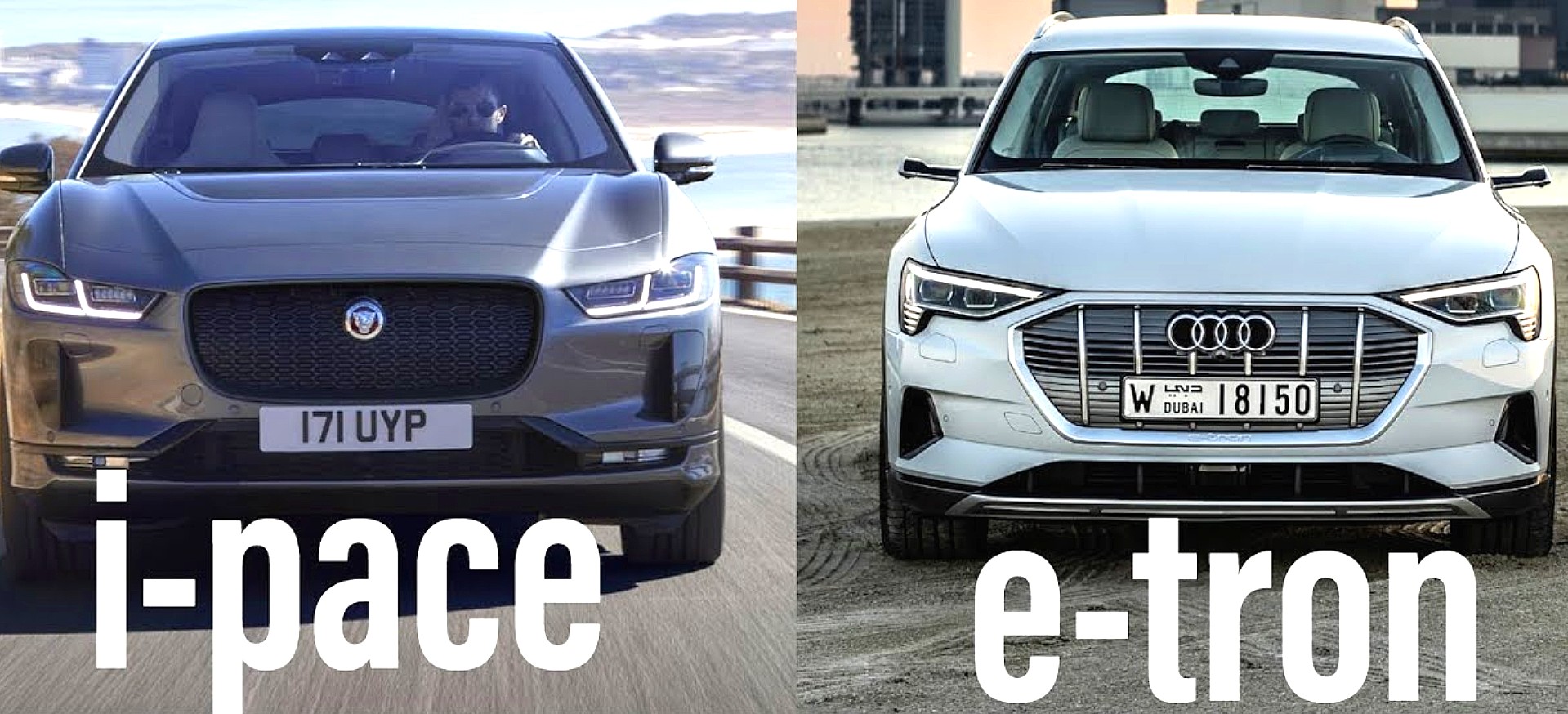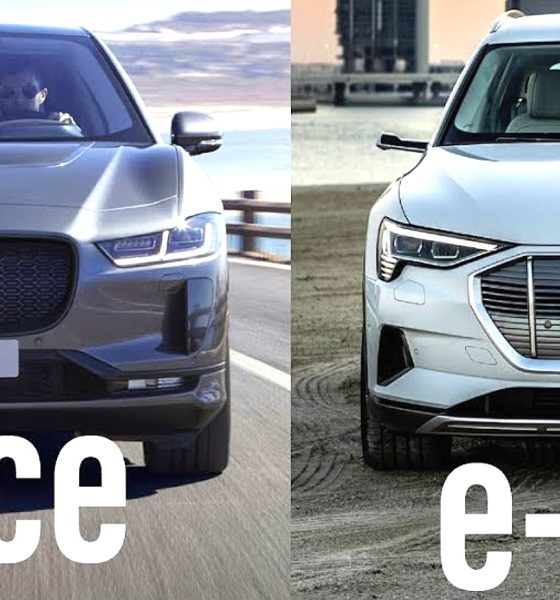

News
‘Tesla fighters’ Audi e-tron, Jaguar I-PACE, face recalls over fire risk, faulty brakes
The Audi e-tron and the Jaguar I-PACE were recently hit by twin recalls over potential safety concerns. Both companies have opted to proactively issue the safety recalls before reports of any untoward incidents concerning the vehicles emerged from owners.
In the case of the Audi e-tron, water can get into the all-electric SUV’s high-voltage charging port, which could then make its way to the vehicle’s electronics, resulting in a potential battery fire. Audi e-tron owner and ServiceNow director Michael Forson recently noted on Twitter that not all of the electric SUVs are affected by the major electrical fault, but the German manufacturer is nonetheless taking the issue seriously. With this in mind, it would not be surprising if Audi ends up inspecting most, if not all, e-trons that have been delivered to customers thus far.
The Jaguar I-PACE, on the other hand, was recently hit by a recall over the vehicle’s regenerative braking system. According to investigators, the I-PACE’s regen brakes could exhibit an “increased delay” between the point when a driver hits the brakes and when the vehicle actually begins slowing down. Jaguar is recalling all of the I-PACE that it has delivered so far, such as the 3,083 units it has sold in the United States.
While Audi is yet to issue a statement about a potential fix to the e-tron’s major electronic safety issue, Jaguar has announced that it already has a solution to the I-PACE’s braking fault. According to the British carmaker, a software update is expected to address the increased delay in the all-electric crossover’s braking system, though this would not be rolled out through an over-the-air update similar to Tesla. Instead, the software update will be distributed through Jaguar’s dealer network at no cost to I-PACE owners. Jaguar is expected to start implementing the firmware update next month.
Both recalls being faced by Audi and Jaguar for the e-tron and I-PACE involves features that are among the fundamentals of electric vehicles. Charging port protection and regenerative braking systems, after all, are basics that more experienced EV makers such as Tesla, and GM for that matter (thanks to the Volt), have learned and mastered over the years. Ultimately, these recalls all but show that designing and producing electric cars are not as easy as Tesla skeptics might think.
While credit must be given to Audi and Jaguar for recalling the e-tron and the I-PACE even before any untoward incidents happened, it should also be noted that Tesla had exhibited the same proactive reaction in the past. Last year, for example, the electric car maker voluntarily recalled 123,000 Model S built before April 2016 due to excessive corrosion in the aluminum power steering bolts supplied by Bosch. This issue, according to Tesla, could make steering the Model S heavier than usual due to the loss or reduction of power assist steering.

News
Tesla FSD fleet is nearing 7 billion total miles, including 2.5 billion city miles
As can be seen on Tesla’s official FSD webpage, vehicles equipped with the system have now navigated over 6.99 billion miles.

Tesla’s Full Self-Driving (Supervised) fleet is closing in on almost 7 billion total miles driven, as per data posted by the company on its official FSD webpage.
These figures hint at the massive scale of data fueling Tesla’s rapid FSD improvements, which have been quite notable as of late.
FSD mileage milestones
As can be seen on Tesla’s official FSD webpage, vehicles equipped with the system have now navigated over 6.99 billion miles. Tesla owner and avid FSD tester Whole Mars Catalog also shared a screenshot indicating that from the nearly 7 billion miles traveled by the FSD fleet, more than 2.5 billion miles were driven inside cities.
City miles are particularly valuable for complex urban scenarios like unprotected turns, pedestrian interactions, and traffic lights. This is also the difference-maker for FSD, as only complex solutions, such as Waymo’s self-driving taxis, operate similarly on inner-city streets. And even then, incidents such as the San Francisco blackouts have proven challenging for sensor-rich vehicles like Waymos.
Tesla’s data edge
Tesla has a number of advantages in the autonomous vehicle sector, one of which is the size of its fleet and the number of vehicles training FSD on real-world roads. Tesla’s nearly 7 billion FSD miles then allow the company to roll out updates that make its vehicles behave like they are being driven by experienced drivers, even if they are operating on their own.
So notable are Tesla’s improvements to FSD that NVIDIA Director of Robotics Jim Fan, after experiencing FSD v14, noted that the system is the first AI that passes what he described as a “Physical Turing Test.”
“Despite knowing exactly how robot learning works, I still find it magical watching the steering wheel turn by itself. First it feels surreal, next it becomes routine. Then, like the smartphone, taking it away actively hurts. This is how humanity gets rewired and glued to god-like technologies,” Fan wrote in a post on X.
News
Tesla starts showing how FSD will change lives in Europe
Local officials tested the system on narrow country roads and were impressed by FSD’s smooth, human-like driving, with some calling the service a game-changer for everyday life in areas that are far from urban centers.

Tesla has launched Europe’s first public shuttle service using Full Self-Driving (Supervised) in the rural Eifelkreis Bitburg-Prüm region of Germany, demonstrating how the technology can restore independence and mobility for people who struggle with limited transport options.
Local officials tested the system on narrow country roads and were impressed by FSD’s smooth, human-like driving, with some calling the service a game-changer for everyday life in areas that are far from urban centers.
Officials see real impact on rural residents
Arzfeld Mayor Johannes Kuhl and District Administrator Andreas Kruppert personally tested the Tesla shuttle service. This allowed them to see just how well FSD navigated winding lanes and rural roads confidently. Kruppert said, “Autonomous driving sounds like science fiction to many, but we simply see here that it works totally well in rural regions too.” Kuhl, for his part, also noted that FSD “feels like a very experienced driver.”
The pilot complements the area’s “Citizen Bus” program, which provides on-demand rides for elderly residents who can no longer drive themselves. Tesla Europe shared a video of a demonstration of the service, highlighting how FSD gives people their freedom back, even in places where public transport is not as prevalent.
What the Ministry for Economic Affairs and Transport says
Rhineland-Palatinate’s Minister Daniela Schmitt supported the project, praising the collaboration that made this “first of its kind in Europe” possible. As per the ministry, the rural rollout for the service shows FSD’s potential beyond major cities, and it delivers tangible benefits like grocery runs, doctor visits, and social connections for isolated residents.
“Reliable and flexible mobility is especially vital in rural areas. With the launch of a shuttle service using self-driving vehicles (FSD supervised) by Tesla in the Eifelkreis Bitburg-Prüm, an innovative pilot project is now getting underway that complements local community bus services. It is the first project of its kind in Europe.
“The result is a real gain for rural mobility: greater accessibility, more flexibility and tangible benefits for everyday life. A strong signal for innovation, cooperation and future-oriented mobility beyond urban centers,” the ministry wrote in a LinkedIn post.
News
Tesla China quietly posts Robotaxi-related job listing
Tesla China is currently seeking a Low Voltage Electrical Engineer to work on circuit board design for the company’s autonomous vehicles.

Tesla has posted a new job listing in Shanghai explicitly tied to its Robotaxi program, fueling speculation that the company is preparing to launch its dedicated autonomous ride-hailing service in China.
As noted in the listing, Tesla China is currently seeking a Low Voltage Electrical Engineer to work on circuit board design for the company’s autonomous vehicles.
Robotaxi-specific role
The listing, which was shared on social media platform X by industry watcher @tslaming, suggested that Tesla China is looking to fill the role urgently. The job listing itself specifically mentions that the person hired for the role will be working on the Low Voltage Hardware team, which would design the circuit boards that would serve as the nervous system of the Robotaxi.
Key tasks for the role, as indicated in the job listing, include collaboration with PCB layout, firmware, mechanical, program management, and validation teams, among other responsibilities. The role is based in Shanghai.
China Robotaxi launch
China represents a massive potential market for robotaxis, with its dense urban centers and supportive policies in select cities. Tesla has limited permission to roll out FSD in the country, though despite this, its vehicles have been hailed as among the best in the market when it comes to autonomous features. So far, at least, it appears that China supports Tesla’s FSD and Robotaxi rollout.
This was hinted at in November, when Tesla brought the Cybercab to the 8th China International Import Expo (CIIE) in Shanghai, marking the first time that the autonomous two-seater was brought to the Asia-Pacific region. The vehicle, despite not having a release date in China, received a significant amount of interest among the event’s attendees.








